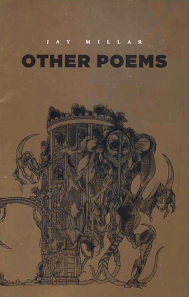Reviews
Poetry Reviews by J. A. Weingarten
Jay MillAr, Other Poems (Gibsons: Nightwood, 2010). Paperbound, 96 pp., $17.95.
Bren Simmers, Night Gears (Hamilton: Wolsak and Wynn, 2010). Paperbound, 80 pp., $17.
Bren Simmers’s Night Gears and Jay MillAr’s Other Poems join a long list of poetry volumes that incorporate the residual Romanticism of much Canadian writing. In the 1920s, Lionel Stevenson claimed that Canadian poets were instinctually Romantic, and when even our most radical writers, such as Irving Layton, seem indebted to this literary tradition, Stevenson’s argument sometimes seems enduring. In the poetry of Simmers and MillAr, this legacy surfaces in different ways: a meditative lyric voice, longing for nature, or modern sublimity, for example. Simmers seems very much at home in pastoral settings: her speakers are calmed, even inspired, by nature. Although their range sometimes seems limited, her poems are genuinely enjoyable lyric meditations on travel, landscape and, sometimes, urbanity. MillAr, too, has pastoral leanings, but the majority of his collection ponders a postmodern lyric. Radical and experimental, the poet constructs a web of “I’s,” “we’s,” and “you’s” that contribute to a charming cacophony, difficult to characterize or categorize, but easy to praise for its ambition.
There is no question that Simmers undertakes her casual saunter across the  Canadian landscape with finesse. As poems that document the quotidian and engage with the natural world, her lyrics seem indebted to writers like Al Purdy (to whom she explicitly alludes in “Northern Postcards”). There is certainly something Purdyesque in Simmers’s occasional self-deprecation, sublime pastoralism, and catalogues of places, animals, and people. And like Purdy, Simmers also manages to develop an “I” that is unmistakably her own: the poignant wit in “Chamisa” and “Office Work” is both consistent and appealing. She deserves praise for her adept conjuring of this neo-Romantic, yet modern, persona.
Canadian landscape with finesse. As poems that document the quotidian and engage with the natural world, her lyrics seem indebted to writers like Al Purdy (to whom she explicitly alludes in “Northern Postcards”). There is certainly something Purdyesque in Simmers’s occasional self-deprecation, sublime pastoralism, and catalogues of places, animals, and people. And like Purdy, Simmers also manages to develop an “I” that is unmistakably her own: the poignant wit in “Chamisa” and “Office Work” is both consistent and appealing. She deserves praise for her adept conjuring of this neo-Romantic, yet modern, persona.
Even if such distinctive personality and sylvan charm makes Night Gears altogether pleasant, the collection sometimes feels narrow in its scope. Many of Simmers’s poems offer only simple snapshots of the natural world. While these snapshots can be gratifying, they lack the nuance of imagist poetry and rarely appeal to anything outside their immediate focus. Consequently, these poems offer somewhat hollow endings. Consider the final lines of “Tomcat”: “Just when you think he’s left / for good, found someone new, / his striped tail swishes through the grass, / a periscope with you in its sights.” Having established the image of the tomcat, Simmers abruptly staggers into an unsatisfying conclusion. Not only does the “periscope” metaphor seem forced and unsuitable, but this section also contains an awkward shift from the “I” who begins the poem to the “you” who ends it. The concluding lines of poems like this (see also, “Dogs of Montoya Street” or “Slatted Fences”) often seem to burden Simmers; the poems are more often halted than concluded with an organic culmination.
This specific shortcoming is troubling because Simmers has quite a few truly impressive poems in Night Gears. This excerpt from “Red Light” is representative:
iPods on, we stare at ads for mouthwash
and technical college until someone asks the time,
and we’re lifted out of the transiting mass
for a few seconds, before slipping back
into starting salary, mid-career goals –
we’re far from where we’d hoped. At a red light,
even the driver stares out the window
The speaker’s quotidian moment is as simplistic as the one in “Tomcat,” but far more intricate in its execution. Brief allusions to contemporary technology such as the iPod root the poem temporally—a significant effect, given “someone’s” question about time. Furthermore, the two askew middle lines nicely highlight the speaker’s experience of distraction, much like the abrupt return to a standard alignment evokes the sensation of “slipping back” into a would-be catalogue of thoughts, halted by the dash. Simmers’s interruptive dash suggests that the catalogue could continue indefinitely, which understandably provokes the speaker’s defeated hope. Although the articulation of self-doubt in the penultimate line sounds clichéd, Simmers’s caesura rescues the phrase from banality with a fitting metaphor (the “red light” is her position in life) that pushes the reader forward. This poem evidences Simmers’s true talent, and further examples could be
pulled from poems such as “At the Seawall,” “Lighthouse Park,” “Kit Carson’s Horses,” and, of course, Simmers’s spectacular concluding long poem, “Northern Postcards.”
In Other Poems, Jay MillAr undertakes a very different project, and I can only  discuss a very small but illustrative portion of his extremely diverse collection. I refer to his experiments with lyric, contiguous with what Douglas Barbour has identified as the “anti-lyric” strain in Canadian writing: lyric poetry that interrogates the limits of lyric. His poems possess vibrant negotiations of form and content:
discuss a very small but illustrative portion of his extremely diverse collection. I refer to his experiments with lyric, contiguous with what Douglas Barbour has identified as the “anti-lyric” strain in Canadian writing: lyric poetry that interrogates the limits of lyric. His poems possess vibrant negotiations of form and content:
A voice of such convexity
Supposedly owing to the elasticity
Of the nervures which are pulled and
So quickly flattened and as quickly
From this oscillation a supposed ticking
Sound will result, the result of which
If you are hearing it correctly, is the
Supposed sound of which I speak, the
Voice, the voice that has been speaking,
The voice of the poet speaking.
These lines from “On Vocal Technique” are admittedly difficult: like Wallace Stevens or Gertrude Stein, MillAr stacks ideas so densely that any illusion of certainty or coherence is left shattered. His active participles, paired with adverbs that qualify and sustain his thought, are enough to leave readers bewildered. Nevertheless, some method to the madness surfaces here and there. “Convexity” appears to allude to one of MillAr’s frequent images: distorted mirrors. Immediately, then, readers should be pondering notions of perception. But how should readers perceive something “elastic,” “flattened,” and “oscillating”? How should they reconcile “nervures” (veins in insect wings) with the “voice of the poet”?
In part, such unanswerable questions about the self define MillAr’s collection; concepts of (self) perception persist throughout this volume, as do questions about “lyric” (the introductory poem is, in fact, called “Lyric”) and “I’s.” Consequently, the confused sense of self in “On Vocal Technique” is hardly unique to the volume: his “I” is, in poems such as “Entropic,” perpetually “[d]ivided,” “diguise[d],” “ablaze,” “under attack,” and “nothing but cliché.” To put it another way, there is something compellingly unromantic about this “I”: it is wholly unsure of itself. And, quite often, this self is lost amidst numerous other voices: bits of Stein, Russian formalist critics, and Robin Blaser overtly enter the poems, and there are (I think) some subtle nods to bill bissett and bpNichol throughout. There are numerous other allusions: the blank spaces in “Entropic” recall Phyllis Webb’s Naked Poems and “Here the horizon is always cut off by trees. / Or buildings” echoes John Newlove’s “Ride off any Horizon.” These allusions are further proof this lyric poet abandons all things Wordsworthian: as part of his poetics, he offers no unified voice or experiences, no unqualified faith in himself, transcendence, spiritual immanence, or epiphanies. MillAr’s hesitant pastoralism also opposes that of Wordsworth, or even that of Simmers: nature acts “dumb,” exhibits “dead things,” and balances “[l]ightness and dark.” These parts partially constitute a dissonant whole: a collection of fragmented voices and Romantic vestiges that struggle wonderfully to cohere. If only because of its demanding intricacy, Other Poems is a collection worth (re)reading, studying, and teaching.
—J. A. Weingarten









